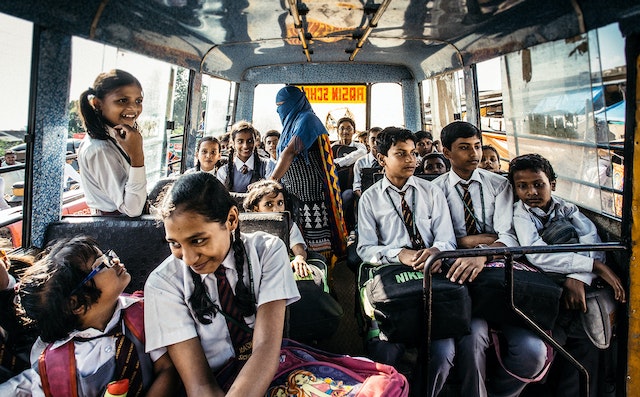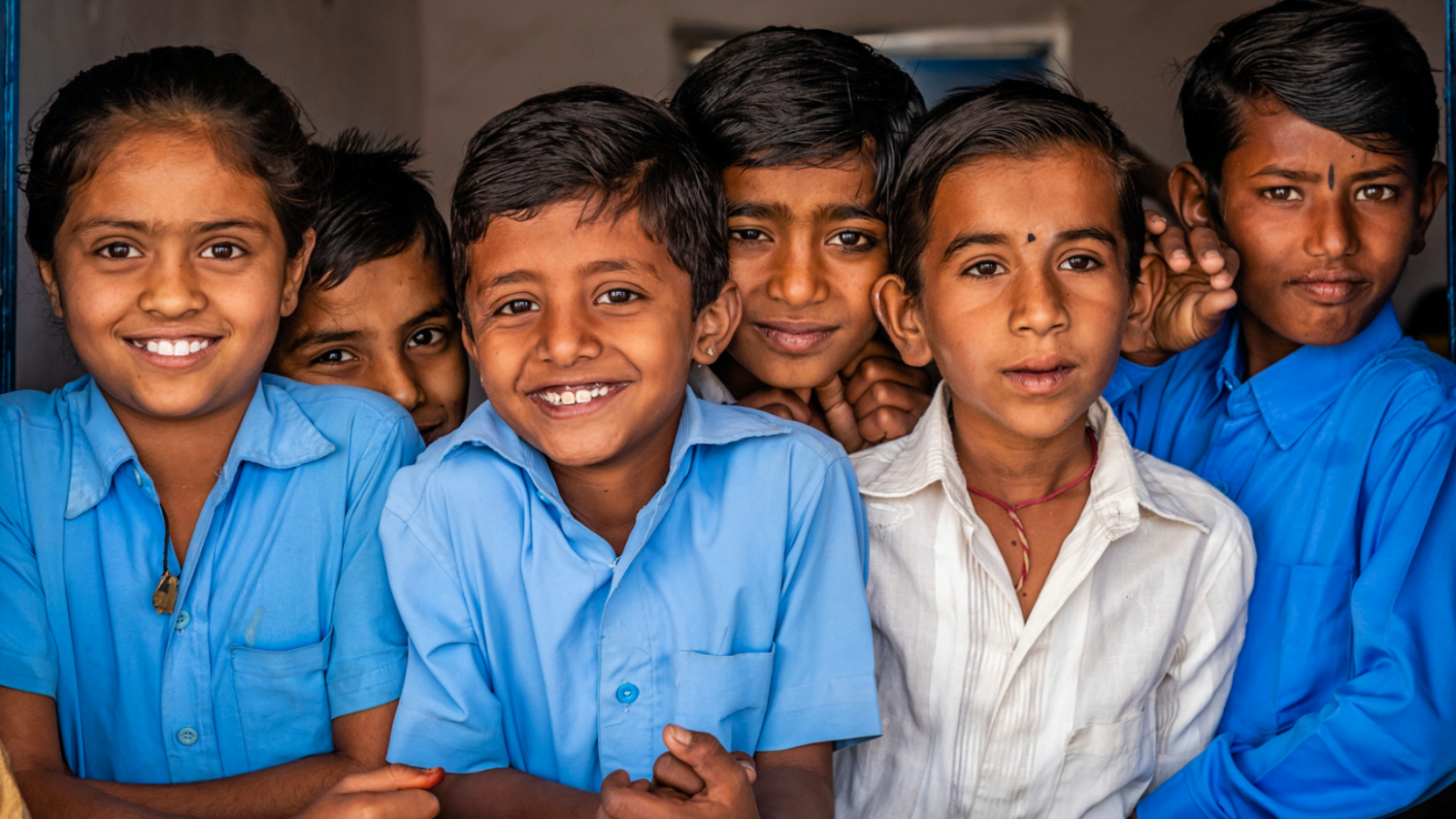
Clearing the Air
A Synthesised Mapping of Out of School Children during COVID-19 in India (April 2020-May 2022)
Context
The COVID-19 pandemic has exacerbated the systemic challenges faced by children in their access to education. During this period, access to schooling resources and materials remained sporadic for a large section of children, and many children remained ‘absent’ or were ‘out of school’ for prolonged periods of time. In India, many efforts were made to document education gaps and experiences of parents and children in their access to schooling. Several surveys were conducted in geographies and communities that organisations, governments, and academics were able to access during school closures, starting from April 2020 (just one month after the first nationwide lockdown).
Samples across these studies however ranged widely in size, geographic dispersion, and on socio-economic backgrounds, and only a few claimed to have attained some representativeness at the national level. Moreover, findings of these studies across the board varied vastly on the status of schooling among sampled children. Similarly, statistics reported by government agencies and representatives on the status of Out of School Children (OOSCs) varied substantially across states and times – from some states reporting a few thousand children dropping out, to statements by ministers indicating millions being out of school.
In the context of varied estimations of the impact of COVID-19 on the OOSC population in India, we synthesise all relevant studies and resources to analyse the status of schooling – across time, geographies, and social and economic backgrounds of households. The objective of the review is to both, provide early insights on how the COVID-19 pandemic may have exacerbated challenges of the OOSC population in the country, and open new research areas or complement existing ones on its differential impact across various groups. We further hope this paper serves as a repository for education researchers and practitioners working on this topic.
In this research, we have systematically compiled and analysed sources of information between April 2020 and May 2022. Three types of sources have been compiled and analysed – (i) nationally representative surveys (conducted by the State and civil society organisations), (ii) COVID-19 specific surveys, and (iii) government surveys (as reported in newspaper articles, statements by government representatives, or official documents published by the government).
In total 72 studies and 110 newspaper articles were identified as being relevant to this study, of which 21 primary research studies have been included in our analysis. These studies are diverse in terms of statistical representativeness, methodologies, and sample sizes.
We find that children across different socioeconomic contexts have been severely affected and educational gaps – in access to educational materials, devices, internet, and other basic resources to continue schooling – were expectedly worse for those with prior disadvantages, and varied across gender, age, region, and disability. Accordingly, incidence of non-enrollment and dropping out was also higher among those with prior disadvantages.
We further find evidence of new sites of exclusion which need attention and inspection. These include; increased incidence of non-enrolments among younger children; further exacerbation of challenges faced by migrant children; and increased vulnerability of children enrolled in low fee private schools.
Definition of Out of School Children or OOSC
In concurrence with the definition of OOSC provided in a government order by the erstwhile Ministry of Human Resource Development in 2018, we consider OOSC to include children who have “dropped-out”, or “not enrolled”, or who have been “absent” from school for a period of 45 days or more without intimation. Due to the reliance on digital education during COVID-19 induced school closures, we capture absenteeism as access to digital education, including availability of smartphones and internet connection.
Across all sources and studies compiled in this report, we find that reported percentages of “drop-outs”, “non-enrollments” and “absenteeism” vary substantially, with a possible explanation for this range provided by when data was collected, who was sampled, and what specific questions were asked to respondents.
Key findings
What do government sources say?
Numbers of the OOSC population reported by the few states who did make data public varied substantially on a range from 25,000 children in Maharashtra (Borwankar, 2020) to over 6.2 lakh children in Jharkhand (Economic Times, 2021).
What do COVID-19 specific studies say?
Across compiled COVID-19-specific surveys, and depending on the period, geography, and/or groups surveyed, it was found that:
- Reported non-enrollments or drop-outs during the pandemic ranged from 1.3 percent (Vernekar et al., 2021) to 43.5 percent (Swabhiman 2020),
- The extent of inaccessibility of devices among sampled respondents ranged from 10 percent (UNICEF, 2020) to 97 percent (Shah, 2020), while
- Inaccessibility of internet connectivity to participate in digital modes of education ranged from 11 percent (ASER, 2020) to 91 percent (Berkhout et al., 2021).
- While there is some evidence of increased penetration of smartphones during the pandemic (ASER, 2021; LIRNEasia & ICRIER, 2021), at its worst, 43 percent children had not had access to any schooling for upto 19 months (due to inaccessibility of digital modes of education or being enrolled in a school that did not offer digital education) (Road Scholarz, 2021).
How does this compare to prior to the pandemic?
Insights from nationally representative Annual Status of Education Report (ASER) and Unified District Information System for Education (UDISE) studies both prior to and during the pandemic show a mixed trend:
- ASER data reported a marginal increase in the percentage of non-enrolled children during COVID-19 (ASER Centre, 2020; ASER Centre, 2021), when compared to data collected in 2018 (ASER Centre, 2018).
- Whereas, Unified District Information System for Education (U-DISE) reported a continued declining trend in drop-outs from 2017-18 to the 2020-21 round of data (UDISE, 2020-21).
Who was worst affected?
Inequalities and continued economic disadvantages that were exacerbated during the pandemic (Kesar et al., 2021), have the destructive potential of undoing decades of work and progress made in education (Berkhout et al., 2021).
Across studies and consistent with evidence of OOSCs prior to the pandemic in India, socially and economically disadvantaged groups and children with disabilities were worst affected (compared to their relatively more advantaged counterparts) in their access to education during the pandemic.
Economically worse-off households had less access to:
- devices and the internet (Ghatak et al., 2020);
- teacher check-ins and home visits (Shah, 2020);
- learning materials (Shah, 2020), and
- online classes (National Council for Applied Economic Research, 2021).
Similarly, children from disadvantaged social groups (Schedules Castes and Scheduled Tribes), had lower access to:
- access to remote learning (UNICEF, 2020);
- educational resources (Vegas et al., 2021), regularity of attending remote classes (Road Scholarz, 2021), and
- time spent on education (Andrew & Salisbury, 2022; Road Scholarz, 2021)
Finally, Children with Disabilities (CWDs) continued to be some of the worst affected by the pandemic:
- Even for CWDs who could access remote classes, modes of instruction were not made accessible (for example, sub-titling or sign language interpretation was not provided for children with hearing impairments) (Lynch et al. 2021; Vernekar et al., 2020).
- The continued apathy towards CWDs’ education is perhaps reflected in the limited studies that documented their plight in accessing education during the pandemic.
On the other hand, evidence on differences in access and attendance to education on the basis of gender and rurality (whether a child resided in a rural or urban area) was mixed.
Findings on the basis of gender show that:
- Girls had lower access to devices, internet, and learning materials and spent less time on education compared to male students (LIRNEasia & ICRIER, 2021; Ghatak et al., 2020).
- However,, Andrew & Salisbury (2022) found no significant difference in learning time and access to remote learning on the basis of gender; and
- One study, in fact, found a gender gap in accessing remote classes in favour of girls (Vegas et al., 2021). This anomaly might be explained by the sample belonging to relatively well-off urban households in a big city in India.
Findings on the basis of rurality show that:
- Urban households reported lower drop-outs and non-enrollments; more access to and higher attendance for education, especially digital education (Road Scholarz, 2021; National Council for Applied Economic Research, 2021; LIRNEasia & ICRIER, 2021); greater ownership and usage of devices and internet connectivity (Road Scholarz, 2021; UNICEF, 2020);
- However, one study found evidence that rural households had more access to physical learning materials (Shah, 2020).
Importantly, we find early evidence of possible new sites of exclusion – specifically among migrant communities, younger children, and children attending low fee private schools.
For instance, with respect to migrant children, limited evidence reflects the continued vulnerability of children belonging to migrant communities in their access and retention in schooling (Shah, 2020; Government of India, 2022). Almost reflective of the difficulty of tracking these students across geographies and schools, as documented even prior to the COVID-19 pandemic (Bhattacharya, 2019), migrant children are sorely underrepresented across studies compiled for the purpose of this report.
Among younger children – in the age-group of primary or pre-primary schooling – we find early evidence of both delays in enrolment in schools as well as differential investments in education in favour of older children.
- Fewer children in younger age groups accessed learning materials, used technology-enabled solutions or remote learning resources, and
- Younger children spent less time on remote learning resources compared to their older counterparts (UNICEF, 2020).
- Another study reported that more than 45 percent of households in their sample prioritised their older children in the use of phones for education, with the rest reporting they do not favour any child (Vernekar et al., 2021).
- Further, while the absolute percentage of non-enrolled children continues to be higher among elder students, ASER data for rural India reported a fall in non-enrolled percentages in the age-group of 15-16 years between the first and second year of the pandemic (a possible early sign of recovery). However, during this same period, the data showed a marginal increase in the “non-enrolled” percent of children in the age groups of 7-14 years (ASER Centre, 2021; ASER Centre, 2020).
- Finally, limited evidence on enrollment rates for children in pre-primary education levels continues to be an issue. State-wise ASER surveys conducted in West Bengal and Chhattisgarh find far higher non-enrolment in the age-group of 3-5 years compared to 6-8 years (ASER Chhattisgarh, 2021; ASER West Bengal, 2021).
Finally, an important area of concern is that of the economic shock faced by low-fee private schools (LFPs) across the country during the pandemic. It was found that:
- Already under-resourced LFPs were unable to invest in digital infrastructure to shift to digital modes of education, salaries of teachers employed in LFPs were delayed or unpaid for months at a time, and ultimately, hundreds of LFPs across the country were forced to shut down (Alam & Tiwari, 2021).
- Moreover, the unaffordability of school fees faced by households during the pandemic led to a large-scale exodus of students from private to government schools (ASER Centre, 2021).
Evidence presented in this paper is still early as effects of the pandemic continue to be realised and observed in various forms. Therefore, it is critical to continue tracking the differential schooling experiences of children on the basis of their background and individual characteristics, as we try to bring children back to schools.
Further, understanding the reach and effectiveness of remedial programmes and initiatives undertaken by the central and state governments is pertinent. For the long term, the need to build a more resilient and adaptive schooling system, and specifically a more resilient public schooling system – through better infrastructure, facilities but also with greater capacity to mobilize and engage communities, and with empowered grassroots stakeholders at a decentralized level – has strongly emerged.





